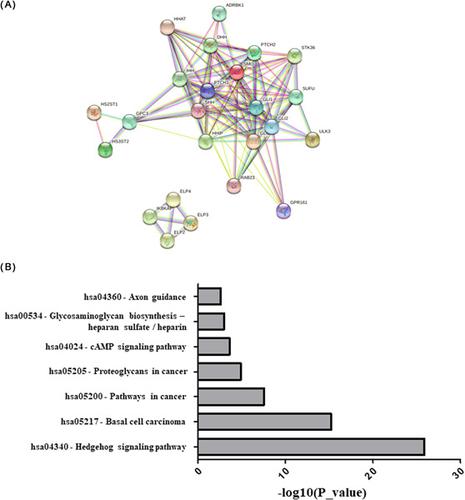当前位置:
X-MOL 学术
›
J. Cell. Biochem.
›
论文详情
Our official English website, www.x-mol.net, welcomes your
feedback! (Note: you will need to create a separate account there.)
Prognostic significance of hedgehog signaling network‐related gene expression in breast cancer patients
Journal of Cellular Biochemistry ( IF 3.0 ) Pub Date : 2021-01-08 , DOI: 10.1002/jcb.29886 Julia Kuehn 1 , Nancy Adriana Espinoza-Sanchez 1, 2 , Felipe C O B Teixeira 3 , Mauro S G Pavão 3 , Ludwig Kiesel 1 , Balázs Győrffy 4 , Burkhard Greve 2 , Martin Götte 1
Journal of Cellular Biochemistry ( IF 3.0 ) Pub Date : 2021-01-08 , DOI: 10.1002/jcb.29886 Julia Kuehn 1 , Nancy Adriana Espinoza-Sanchez 1, 2 , Felipe C O B Teixeira 3 , Mauro S G Pavão 3 , Ludwig Kiesel 1 , Balázs Győrffy 4 , Burkhard Greve 2 , Martin Götte 1
Affiliation

|
Breast cancer continues to be a serious public health problem. The role of the hedgehog pathway in normal development of the mammary gland as well as in carcinogenesis and progression of breast cancer is the subject of intense investigation, revealing functional interactions with cell surface heparan sulfate. Nevertheless, its influence on breast cancer prognosis, and its relation to specific sulfation motifs in heparan sulfate have only been poorly studied in large patient cohorts. Using the public database KMplotter that includes gene expression and survival data of 3951 patients, we found that the higher expression of SHH, HHAT, PTCH1, GLI1, GLI2, and GLI3 positively influences breast cancer prognosis. Stratifying patients according to the expression of hormone receptors, histological grade, lymph node metastasis, and systemic therapy, we observed that GLI1, GLI2, and GLI3 expression, as well as co‐expression of SHH and ELP1 were associated with worse relapse‐free survival in patients with HER2‐positive tumors. Moreover, GLI1 expression in progesterone receptor‐negative tumors and GLI3 expression in grade 3 tumors correlated with poor prognosis. SHH, in a panel of cell lines representing different breast cancer subtypes, and HHAT, PTCH1, GLI1, GLI2, and GLI3 were mostly expressed in cell lines classified as HER2‐positive and basal‐like. Expression of SHH, HHAT, GLI2, and GLI3 was differentially affected by overexpression of the heparan sulfate sulfotransferases HS2ST1 and HS3ST2 in vitro. Although high HS2ST1 expression was associated with poor prognosis in KMplotter analysis, high levels of HS3ST2 were associated with a good prognosis, except for ER‐positive breast cancer. We suggest the GLI transcription factors as possible markers for the diagnosis, treatment, and prognosis of breast cancer especially in HER2‐positive tumors, but also in progesterone receptor‐negative and grade‐3 tumors. The pathway interaction and prognostic impact of specific heparan sulfate sulfotransferases provide novel perspectives regarding a therapeutical targeting of the hedgehog pathway in breast cancer.
中文翻译:

乳腺癌患者Hedgehog信号网络相关基因表达的预后意义
乳腺癌仍然是一个严重的公共卫生问题。刺猬通路在乳腺正常发育以及乳腺癌的癌变和进展中的作用是深入研究的主题,揭示了与细胞表面硫酸乙酰肝素的功能相互作用。然而,它对乳腺癌预后的影响,以及它与硫酸乙酰肝素中特定硫酸化基序的关系,仅在大型患者队列中研究得很少。使用包含 3951 名患者的基因表达和生存数据的公共数据库 KMplotter,我们发现SHH、HHAT、PTCH1、GLI1、GLI2和GLI3的较高表达积极影响乳腺癌的预后。根据激素受体的表达、组织学分级、淋巴结转移和全身治疗对患者进行分层,我们观察到GLI1、GLI2和GLI3 的表达以及SHH和ELP1 的共表达与较差的无复发生存相关在 HER2 阳性肿瘤患者中。此外,孕激素受体阴性肿瘤中的GLI1表达和3 级肿瘤中的GLI3表达与不良预后相关。SHH,在代表不同乳腺癌亚型的一组细胞系中,以及HHAT、PTCH1、GLI1、GLI2和GLI3主要在分类为 HER2 阳性和基底样的细胞系中表达。的表达SHH,HHAT,GLI2,和GLI3被差异影响通过硫酸乙酰肝素磺基转移酶的过表达HS2ST1和HS3ST2体外。尽管在 KMplotter 分析中高HS2ST1表达与不良预后相关,但高水平的HS3ST2除 ER 阳性乳腺癌外,均与良好的预后相关。我们建议将 GLI 转录因子作为乳腺癌诊断、治疗和预后的可能标志物,尤其是在 HER2 阳性肿瘤中,以及在孕激素受体阴性和 3 级肿瘤中。特定硫酸乙酰肝素磺基转移酶的通路相互作用和预后影响为乳腺癌中刺猬通路的治疗靶向提供了新的视角。
更新日期:2021-01-08
中文翻译:

乳腺癌患者Hedgehog信号网络相关基因表达的预后意义
乳腺癌仍然是一个严重的公共卫生问题。刺猬通路在乳腺正常发育以及乳腺癌的癌变和进展中的作用是深入研究的主题,揭示了与细胞表面硫酸乙酰肝素的功能相互作用。然而,它对乳腺癌预后的影响,以及它与硫酸乙酰肝素中特定硫酸化基序的关系,仅在大型患者队列中研究得很少。使用包含 3951 名患者的基因表达和生存数据的公共数据库 KMplotter,我们发现SHH、HHAT、PTCH1、GLI1、GLI2和GLI3的较高表达积极影响乳腺癌的预后。根据激素受体的表达、组织学分级、淋巴结转移和全身治疗对患者进行分层,我们观察到GLI1、GLI2和GLI3 的表达以及SHH和ELP1 的共表达与较差的无复发生存相关在 HER2 阳性肿瘤患者中。此外,孕激素受体阴性肿瘤中的GLI1表达和3 级肿瘤中的GLI3表达与不良预后相关。SHH,在代表不同乳腺癌亚型的一组细胞系中,以及HHAT、PTCH1、GLI1、GLI2和GLI3主要在分类为 HER2 阳性和基底样的细胞系中表达。的表达SHH,HHAT,GLI2,和GLI3被差异影响通过硫酸乙酰肝素磺基转移酶的过表达HS2ST1和HS3ST2体外。尽管在 KMplotter 分析中高HS2ST1表达与不良预后相关,但高水平的HS3ST2除 ER 阳性乳腺癌外,均与良好的预后相关。我们建议将 GLI 转录因子作为乳腺癌诊断、治疗和预后的可能标志物,尤其是在 HER2 阳性肿瘤中,以及在孕激素受体阴性和 3 级肿瘤中。特定硫酸乙酰肝素磺基转移酶的通路相互作用和预后影响为乳腺癌中刺猬通路的治疗靶向提供了新的视角。







































 京公网安备 11010802027423号
京公网安备 11010802027423号